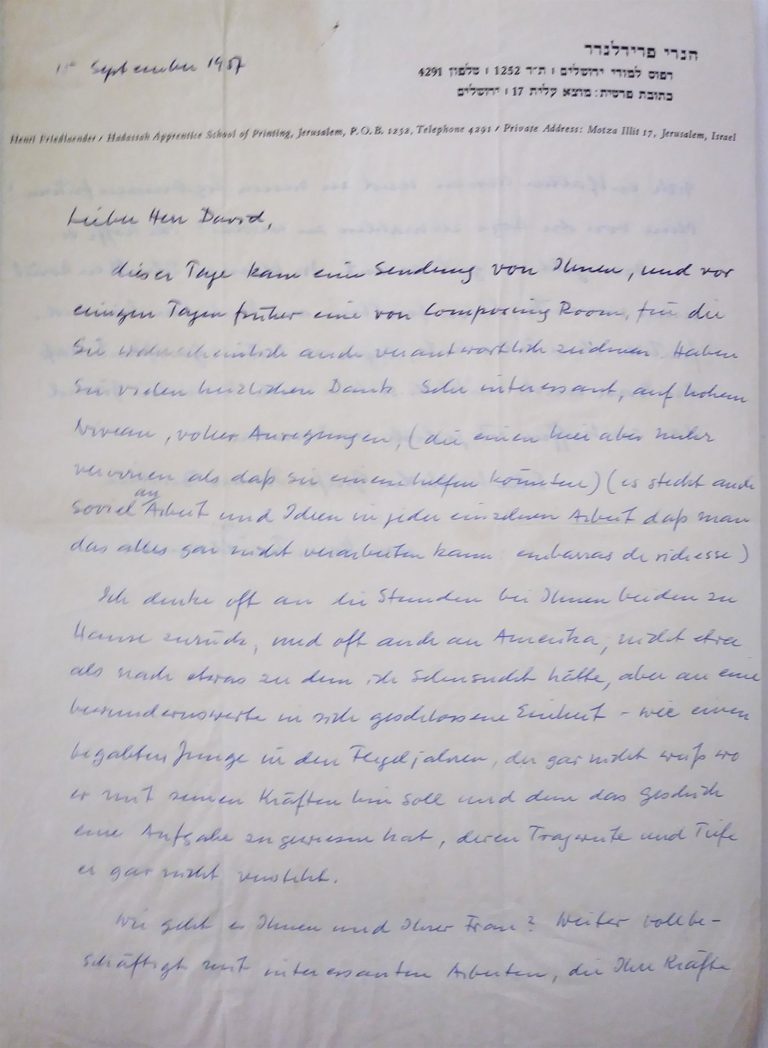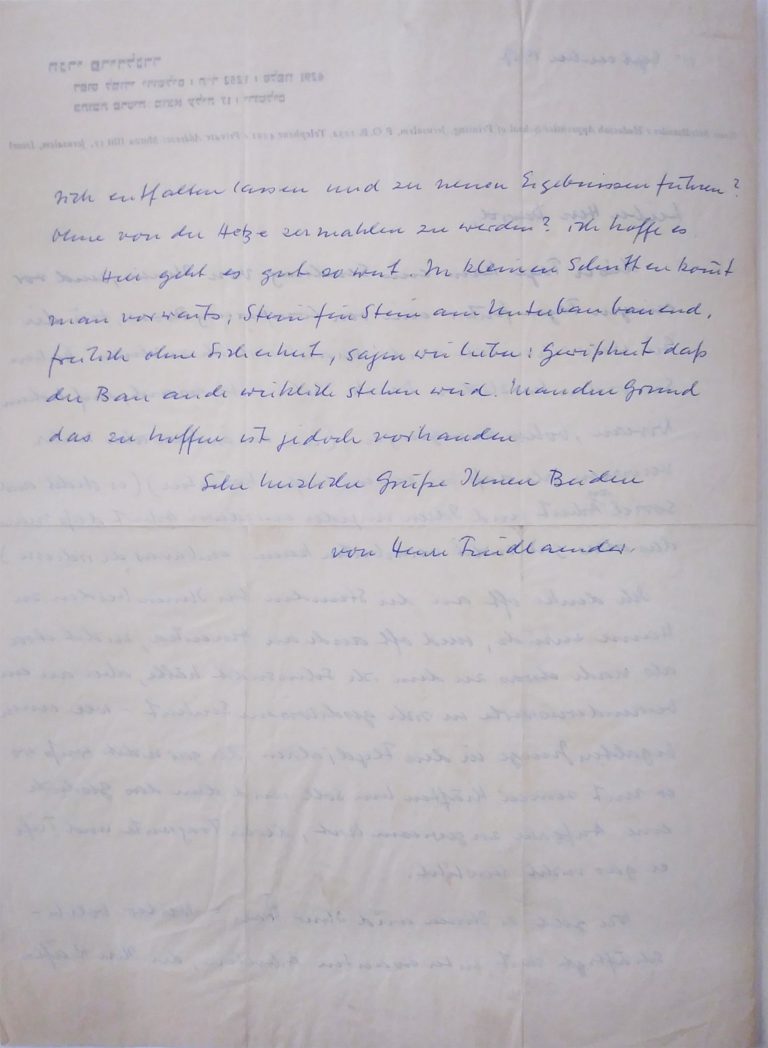Henri Friedlaender, 1904–1996, type and book designer, co-founded the Hadassah Printing School and served as its first director.
Henri Friedlaender described his multi-national heritage:
Von Frankreich hatte ich die Liebe zu Klarheit in Form und Wort bekommen; von England Wertschätzung für geschichtlich Gewachsenes und für Weltweite; von Deutschland meine Fachkenntnisse und ein Ahnen der Nachtseite der sichtbaren Dinge; von Holland die Erfahrung, daß schlichte Menschlichkeit wichtiger ist als Spitzenleistungen…1Friedlaender, Henri, Die Entstehung meiner Hadassah-Hebräisch. Hamburg 1967: 37.
From France, I got the love of clarity in form and word; from England, the appreciation of growth over time and the greater world; from Germany, my technical expertise and an inkling of the dark side of visible things; from Holland, the experience, that simple humanity is more important than excellence…
Lyon-born Henri Friedlaender moved to Berlin when he was six years old with his English mother and German father and received all his primary and secondary education there. After graduating from the Mommsen Gymnasium in Charlottenburg, he apprenticed in various printing methods, gaining experience in hand setting, letterpress and intaglio, as well as administrative exposure to engraving. He taught himself lettering and studied for a year at the Akademie für Graphische Künste und Buchgewerbe in Leipzig. Beginning in 1932, he was art director at Mouton & Co. in the Hague. During the Nazi occupation of the Netherlands, Friedlaender could neither live nor work openly and was forced to hide in his own house, seeing only his wife. In 1950 the couple emigrated to Israel, where he founded and led the Hadassah Apprentice School of Printing in Jerusalem. After retiring, he continued working as a free-lance book designer and taught at the Bezalel Academy of Art.
Friedlaender is best known as the designer of Hadassah, a type face he began in 1931, when Schocken asked the Haag-Drugulin Foundry, where he was a printer-manager, whether a modern Hebrew typeface could be created. Haag-Drugulin’s partipation ceased, when Friedlaender left for Holland. Nevertheless he continued developing his ideas. Lettergieterij Amsterdam produced a trial casting in 1949, which necessitated considerable revision. Hadassah was finally issued in 1958. Friedlander also designed three Hebrew typefaces for the IBM Selectric typewriter II typeball: Shalom, Hadar, and Aviv.
In his essay, Toward a Modern Hebrew, in 1959 Friedlaender wrote: “Ismar David started from the simplified Hebrew he had evolved in his practice of lettering. He tried to preserve in type as much as possible of its modern, free character. In the sloped version moreover he introduced motives of italic semicursive, originated in the fourteenth century but still alive. The resulting type is charming, elegant and well suited for not too long texts. For books it is a little too playful and not quite restrained enough.”2Friedlaender, Henri, Toward a Modern Hebrew.P.A..G.A.: Printing & Graphic Arts 7 (1959): 43-56.
Friedlaender must have visited Hortense Mendel and Ismar David in New York during the mid-fifties.
15 September 1957
Dear Mr. David,A package from you arrived today, and a few days earlier one from the Composing Room, for which you are probably also responsible. Many heartfelt thanks. Very interesting, at a high standard, full of motivation, (which are here more confusing than helpful) (there is also so much work and ideas packed in each and every work, that one can’t process it all—an embarrassment of riches [in French])
I often think back to the hours [with you two] at your home, and also often of America, not in the sense of something I would long for, but as an admirable self-contained entity—like a gifted boy in his teens, who doesn’t at all know where to go with his powers and to whom fate assigned a task, the scope and depth of which he doesn’t understand at all. How are you and your wife? Fully engaged again with interesting work that takes full advantage of your abilities and leads to new discoveries? Without being ground up by the [rat] race? I hope so.
Here, so far, it’s going well. One goes forward in small steps, building the foundation stone by stone, admittedly without the assurance, or let’s rather say: the certainty, that the building will also really stand. Some basis for hope, however, exists.
Best regards to both of you
from Henri Friedlaender



























